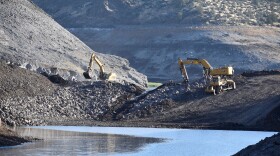The largest dam removal and river restoration in U.S. history is taking place on the Klamath River, along the Oregon-California border. It marks the culmination of two decades of activism from local Native American tribes and conservationists, and it promises to have major impacts on communities in the region. Jefferson Public Radio is documenting this historic project.
-
Just a year after four dams were removed, fall Chinook have migrated nearly 300 miles into the Upper Klamath Basin in Southern Oregon.
-
After decades of conflict, farmers and tribes say they’re working in concert to restore salmon habitat in the Klamath Basin. But two dams remain.
-
Chinook salmon are spawning in streams above four former dam sites on the Klamath River in numbers that are astounding biologists. Now, a network of tribes, agencies, university researchers, and conservation groups is working together to track the fish as they explore the newly opened habitat.
-
Now that two temporary cofferdams—one at Iron Gate dam; one at Copco 1—have been breached, the Klamath is running freely, and salmon will be able to access 420 miles of habitat that had been blocked by the dams.
-
The Siskiyou County Supervisors had asked for the emergency declaration in response to water quality concerns related to Klamath River dam removal.
-
A new landscape and river are emerging in the Klamath Basin.
-
The agreement marks a significant moment for the tribe, which has been without a land base for over 100 years.
-
Will the restoration of Klamath River runs help restore California’s struggling salmon fishing industry?
-
Deconstruction of Iron Gate dam, the lowest of the four dams along the Oregon-California border, has begun.
-
By the end of the week, the California Department of Fish and Wildlife will have released 90,000 yearling coho as well as 400,000 Chinook salmon fry into the Klamath River.
-
The Siskiyou County Board of Supervisors recently proclaimed a local emergency related to concerns about heavy metals being present in the Klamath River. California's regional water board says those worries are overblown.
-
On Tuesday, the Siskiyou County Board of Supervisors proclaimed a local emergency and requested that the governor proclaim a state of emergency based on water quality concerns in the Klamath River as four dams are being removed.
-
Approximately 830,000 fall-run Chinook salmon fry are believed to have died while passing through the lowest dam on the Klamath River in late February.
-
With the drawdown of three reservoirs complete, the Klamath River is flowing more or less within its historic channel.















